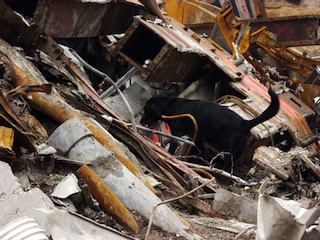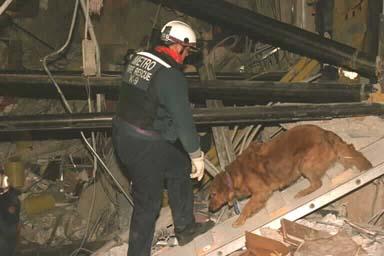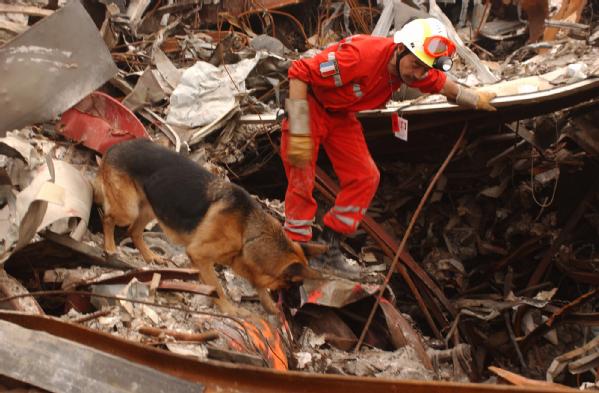|
Training your K9 for Urban Search and Rescue
Urban Search and Rescue K9. Photo Courtesy of FEMA.
The only national standards for Urban Search and Rescue teams in urban disaster work are FEMA certification standards. K9 training for Urban Disaster Work or (USAR) can be rigorous, and the FEMA standards very difficult to meet. The K9 handler needs to pass certain required courses and tests. Some of these may include First Responder, CPR, EMT, Swiftwater Awareness, and Incident Command. There are many courses that can be taken. The more skills you have as a handler, the more you can help your team. The first step in the training process is for your K9 to have the basic training and understanding of commands down. At this point in the training, you will already have decided what reward system you will use. You know what your dog works for...the toy or the treat. You will now need to determine which training techniques will do the best job for your dog. What works with one K9 will not necessarily work for another. Teaching Your K9 The Bark Alert In Urban Search and Rescue, you need to teach your dog the bark alert. Even if you are out of site of the victim, your dog needs to be able to indicate he's found someone. You can teach this alert at the puppy stage at home, just by rewarding him when he barks at the appropriate time. Eventually he will recognize when you attach the "speak" or "bark" command to the training. To start, find a toy or treat that motivates your dog. Find a place free of distractions for training. Tease your dog by showing him the toy, but don't let him get it. Hide it in your chest and turn away. This will frustrate you dog into a bark. Reward him, even if it's for the smallest whimper. You may find yourself looking a bit foolish running around teasing, but you need to do whatever it takes to get him so excited he barks. Do not over do the training. About 4 or 5 times is plenty. Too much and he will lose interest. Once you have a solid bark, move on to victim loyalty. The helper will now be giving the same cues that you gave to have the dog bark. Your dog needs to put all his focus on the helper, or "victim". This way he learns to bark when he finds the victim, which is the real reason he's learning this! Once he is barking at the helper, use different people to hide, and increase the number of barks until he gets the reward. You want him to be excited each time he finds someone, and to bark immediately without any verbal commands. Runaways Holding on to your dog, have the helper tease him with his favorite toy (or treat). The helper should run in a straight line (downwind) as your dog watches. When your helper is about 50 feet away, let go of the leash, and give him a "search" or "find" command. When he reaches the helper and barks, he will be rewarded with his toy. Do a few sets of these, then move farther away to make it more of a challenge. Give the dog variety by laying down, or crouching when you hide. Now you're ready for alert barrel training. A 55 gallon drum laying on the ground works well for this training. Your helper will be hiding inside the container, without the lid secured, so the dog can see them. Again, do the runaway just as before. At this point, your dog should be barking to alert you of the "victim" in the barrel. Again, practice a few sets of this and be sure he has the bark alert down. If he doesn't, then you need to back up a few steps and practice more. Once he has this step down, you can place a lid over the front of the barrel so he cannot see the victim. Don't place the lid on tightly. You don't want to endanger your helper. Again, from a distance, give your dog the "search" or "find" command, and when he finds the helper, he should alert with barking. Reward him for a job well done! After your dog is finding the helper and has his bark alert down well, introduce him to distractions. These distractions can be a toy (not his favorite toy), food, or a piece of machinery. There are a million distractions in Urban Search and Rescue. Your dog needs to ignore them, and focus on the job at hand. If he becomes distracted, you should use the Leave It command. Once he finds the helper and barks, the helper should reward and praise him.
Urban Search and Rescue K9. Photo courtesy of FEMA. Agility Training When you start out, keep it simple. Don't let your pup fall, or become afraid of the obstacles he will be working around. Give him playtime at the end of training so he relates training to fun. To help control your dog during agility training, use food treats for rewards. You don't want your dog to run through the coarse too quickly, so you may need to work on obedience to keep them at a controlled speed. If you're building your own course, here are some ideas you could use. Constructing an Urban Search and Rescue Agility Course. Moving Obstacles Walking on slippery surfaces Feet Placement Direction and Control You will need to decide which commands you will use for a specific behavior or to direct him to a particular area. You also need to decide which hand signals you will be using. You need each signal to be obvious to where your dog will recognize it from a distance. Again, you will need a reward (preferably food) as you teach the new skills.
Urban Search and Rescue K9. Photo courtesy of FEMA. Photographer Michael Rieger. Building Your Canine's Endurance If you're thinking of jogging or walking with your dog, let him walk on the grass or dirt. Pavement and asphalt is not only hard on their joints, but also their pads. They also make doggie boots to protect their pads if the hard pavement is unavoidable. **Here are a few fitness games you can do with your dog.
"Return from "Urban Search and Rescue" to "Training Homepage"
|



